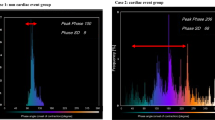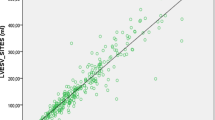Abstract
Purpose
Left ventricular mechanical dyssynchrony (LVMD) is an important prognostic factor in coronary artery disease. A growing body of evidence indicates that LVMD parameters derived from phase analysis of gated myocardial SPECT may allow risk stratification for future cardiac events. We performed a systematic review and meta-analysis on the prognostic value of LVMD on gated SPECT in patients with coronary artery disease.
Methods
PubMed, Embase, and the Cochrane library were searched until August 25, 2022, for studies reporting the prognostic value of LVMD on gated SPECT for outcomes of all-cause death, cardiac death, or major adverse cardiovascular event (MACE) in patients with coronary artery disease. Hazard ratios (HRs) and their 95% confidence intervals (CIs) were meta-analytically pooled using a random-effects model.
Results
Nine studies (26,750 patients) were included in a qualitative synthesis. Among the SPECT LVMD parameters used in various studies, high phase standard deviation, phase bandwidth, and phase entropy were widely evaluated and reported to be associated with high rates of all-cause death, cardiac death, or MACE. For five studies (23,973 patients) in the quantitative synthesis, the pooled HR of LVMD for predicting MACE was 2.81 (95% CI 2.03–3.88). Studies using combined phase parameters to define LVMD showed higher HRs than a study using phase entropy (p = 0.0180).
Conclusion
LVMD from gated myocardial SPECT is a significant prognostic factor for coronary artery disease. Phase analysis of gated SPECT may be useful for accurate risk stratification and could be applied for clinical decision-making in such patients.




Similar content being viewed by others
Data availability
The data that support the findings of this study are available from the corresponding author upon reasonable request.
References
Strickberger SA, Conti J, Daoud EG, Havranek E, Mehra MR, Piña IL, Young J. Patient selection for cardiac resynchronization therapy: from the council on clinical cardiology subcommittee on electrocardiography and arrhythmias and the quality of care and outcomes research interdisciplinary working group, in collaboration with the Heart Rhythm Society. Circulation. 2005;111:2146–50.
Epstein AE, DiMarco JP, Ellenbogen KA, Estes NA 3rd, Freedman RA, Gettes LS, et al. 2012 ACCF/AHA/HRS focused update incorporated into the ACCF/AHA/HRS 2008 guidelines for device-based therapy of cardiac rhythm abnormalities: a report of the American College of Cardiology Foundation/American Heart Association Task Force on Practice Guidelines and the Heart Rhythm Society. J Am Coll Cardiol. 2013;61:e6-75.
Bleeker GB, Schalij MJ, Molhoek SG, Verwey HF, Holman ER, Boersma E, et al. Relationship between QRS duration and left ventricular dyssynchrony in patients with end-stage heart failure. J Cardiovasc Electrophysiol. 2004;15:544–9.
Marcus GM, Rose E, Viloria EM, Schafer J, De Marco T, Saxon LA, Foster E. Septal to posterior wall motion delay fails to predict reverse remodeling or clinical improvement in patients undergoing cardiac resynchronization therapy. J Am Coll Cardiol. 2005;46:2208–14.
Chung ES, Leon AR, Tavazzi L, Sun JP, Nihoyannopoulos P, Merlino J, et al. Results of the predictors of response to CRT (PROSPECT) trial. Circulation. 2008;117:2608–16.
Rajiah P, François CJ. Cardiac MRI for left ventricular dyssynchrony: time for coordinated response. Radiol Cardiothorac Imaging. 2021;3: e210193.
Gulati M, Levy PD, Mukherjee D, Amsterdam E, Bhatt DL, Birtcher KK, et al. 2021 AHA/ACC/ASE/CHEST/SAEM/SCCT/SCMR guideline for the evaluation and diagnosis of chest pain: a report of the American College of Cardiology/American Heart Association Joint Committee on Clinical Practice Guidelines. Circulation. 2021;144:e368–454.
Chen J, Garcia EV, Bax JJ, Iskandrian AE, Borges-Neto S, Soman P. SPECT myocardial perfusion imaging for the assessment of left ventricular mechanical dyssynchrony. J Nucl Cardiol. 2011;18:685–94.
Cho SG, Jabin Z, Park KS, Kim J, Kang SR, Kwon SY, et al. Clinical values of left ventricular mechanical dyssynchrony assessment by gated myocardial perfusion SPECT in patients with acute myocardial infarction and multivessel disease. Eur J Nucl Med Mol Imaging. 2017;44:259–66.
Fudim M, Fathallah M, Shaw LK, Liu PR, James O, Samad Z, et al. The prognostic value of diastolic and systolic mechanical left ventricular dyssynchrony among patients with coronary heart disease. JACC Cardiovasc Imaging. 2019;12:1215–26.
Hess PL, Shaw LK, Fudim M, Iskandrian AE, Borges-Neto S. The prognostic value of mechanical left ventricular dyssynchrony defined by phase analysis from gated single-photon emission computed tomography myocardial perfusion imaging among patients with coronary heart disease. J Nucl Cardiol. 2017;24:482–90.
Kuronuma K, Miller RJH, Otaki Y, Van Kriekinge SD, Diniz MA, Sharir T, et al. Prognostic value of phase analysis for predicting adverse cardiac events beyond conventional single-photon emission computed tomography variables: results from the REFINE SPECT registry. Circ Cardiovasc Imaging. 2021;14: e012386.
Miyagawa M, Yoda S, Fujito H, Hatta T, Tanaka Y, Fukumoto K, et al. Prognostic risk stratification based on left ventricular mechanical dyssynchrony in patients at low or intermediate risk of major cardiac events using the J-ACCESS risk model. Heart Vessels. 2023;38:195-206.
Pazhenkottil AP, Buechel RR, Husmann L, Nkoulou RN, Wolfrum M, Ghadri JR, et al. Long-term prognostic value of left ventricular dyssynchrony assessment by phase analysis from myocardial perfusion imaging. Heart. 2011;97:33–7.
Tian Y, Zhao M, Li W, Zhu Z, Mi H, Li X, Zhang X. Left ventricular mechanical dyssynchrony analzyed by Tc-99m sestamibi SPECT and F-18 FDG PET in patients with ischemic cardiomyopathy and the prognostic value. Int J Cardiovasc Imaging. 2020;36:2063–71.
Uebleis C, Hellweger S, Laubender RP, Becker A, Sohn HY, Lehner S, et al. Left ventricular dyssynchrony assessed by gated SPECT phase analysis is an independent predictor of death in patients with advanced coronary artery disease and reduced left ventricular function not undergoing cardiac resynchronization therapy. Eur J Nucl Med Mol Imaging. 2012;39:1561–9.
Zhang H, Shi K, Fei M, Fan X, Liu L, Xu C, et al. A left ventricular mechanical dyssynchrony-based nomogram for predicting major adverse cardiac events risk in patients with ischemia and no obstructive coronary artery disease. Front Cardiovasc Med. 2022;9: 827231.
Moher D, Liberati A, Tetzlaff J, Altman DG, Group P. Preferred reporting items for systematic reviews and meta-analyses: the PRISMA statement. PLoS Med. 2009;6:e1000097.
Hayden JA, van der Windt DA, Cartwright JL, Côté P, Bombardier C. Assessing bias in studies of prognostic factors. Ann Intern Med. 2013;158:280–6.
Guyot P, Ades AE, Ouwens MJ, Welton NJ. Enhanced secondary analysis of survival data: reconstructing the data from published Kaplan-Meier survival curves. BMC Med Res Methodol. 2012;12:9.
Higgins JP, Thompson SG, Deeks JJ, Altman DG. Measuring inconsistency in meta-analyses. Bmj. 2003;327:557–60.
Egger M, Davey Smith G, Schneider M, Minder C. Bias in meta-analysis detected by a simple, graphical test. BMJ. 1997;315:629–34.
Trimble MA, Velazquez EJ, Adams GL, Honeycutt EF, Pagnanelli RA, Barnhart HX, et al. Repeatability and reproducibility of phase analysis of gated single-photon emission computed tomography myocardial perfusion imaging used to quantify cardiac dyssynchrony. Nucl Med Commun. 2008;29:374–81.
Chen J, Garcia EV, Folks RD, Cooke CD, Faber TL, Tauxe EL, Iskandrian AE. Onset of left ventricular mechanical contraction as determined by phase analysis of ECG-gated myocardial perfusion SPECT imaging: development of a diagnostic tool for assessment of cardiac mechanical dyssynchrony. J Nucl Cardiol. 2005;12:687–95.
Okuda K, Nakajima K, Matsuo S, Kashiwaya S, Yoneyama H, Shibutani T, et al. Comparison of diagnostic performance of four software packages for phase dyssynchrony analysis in gated myocardial perfusion SPECT. EJNMMI Res. 2017;7:27.
Nakajima K, Matsumoto N, Kasai T, Matsuo S, Kiso K, Okuda K. Normal values and standardization of parameters in nuclear cardiology: Japanese Society of Nuclear Medicine working group database. Ann Nucl Med. 2016;30:188–99.
Chen CC, Huang WS, Hung GU, Chen WC, Kao CH, Chen J. Left-ventricular dyssynchrony evaluated by Tl-201 gated SPECT myocardial perfusion imaging: a comparison with Tc-99m sestamibi. Nucl Med Commun. 2013;34:229–32.
Zhou Y, Li D, Feng J, Yuan D, Patel Z, Cao K, Chen J. Left ventricular dyssynchrony parameters measured by phase analysis of post-stress and resting gated SPECT myocardial perfusion imaging. World J Nucl Med. 2013;12:3–7.
Aljaroudi W, Koneru J, Heo J, Iskandrian AE. Impact of ischemia on left ventricular dyssynchrony by phase analysis of gated single photon emission computed tomography myocardial perfusion imaging. J Nucl Cardiol. 2011;18:36–42.
Chen CC, Shen TY, Chang MC, Hung GU, Chen WC, Kao CH, Chen J. Stress-induced myocardial ischemia is associated with early post-stress left ventricular mechanical dyssynchrony as assessed by phase analysis of 201Tl gated SPECT myocardial perfusion imaging. Eur J Nucl Med Mol Imaging. 2012;39:1904–9.
Singh H, Patel CD, Sharma P, Naik N, Singh S, Narang R. Does perfusion pattern influence stress-induced changes in left ventricular mechanical dyssynchrony on thallium-201-gated SPECT myocardial perfusion imaging? J Nucl Cardiol. 2015;22:36–43.
Henzlova MJ, Duvall WL, Einstein AJ, Travin MI, Verberne HJ. ASNC imaging guidelines for SPECT nuclear cardiology procedures: Stress, protocols, and tracers. J Nucl Cardiol. 2016;23:606–39.
Souza Filho EMD, Tinoco Mesquita C, Altenburg Gismondi R, Amorim Fernandes FD, Jan Verberne H. Are there normal values of phase analysis parameters for left ventricular dyssynchrony in patients with no structural cardiomyopathy?: A systematic review. Nucl Med Commun. 2019;40:980–5.
Aide N, Lasnon C, Veit-Haibach P, Sera T, Sattler B, Boellaard R. EANM/EARL harmonization strategies in PET quantification: from daily practice to multicentre oncological studies. Eur J Nucl Med Mol Imaging. 2017;44:17–31.
Nakajima K, Okuda K, Matsuo S, Slomka P. Making the invisible visible: phase dyssynchrony has potential as a new prognostic marker. J Nucl Cardiol. 2019;26:298–302.
Nakahara T, Daisaki H, Yamamoto Y, Iimori T, Miyagawa K, Okamoto T, et al. Use of a digital phantom developed by QIBA for harmonizing SUVs obtained from the state-of-the-art SPECT/CT systems: a multicenter study. EJNMMI Res. 2017;7:53.
Bosco E, Hsueh L, McConeghy KW, Gravenstein S, Saade E. Major adverse cardiovascular event definitions used in observational analysis of administrative databases: a systematic review. BMC Med Res Methodol. 2021;21:241.
Funding
This research was supported by a grant from the Korea Health Technology R&D Project through the Korea Health Industry Development Institute (KHIDI), funded by the Ministry of Health & Welfare, Republic of Korea (grant number: HR18C0016).
Author information
Authors and Affiliations
Contributions
Koeun Lee and Sangwon Han contributed to study conceptualization, data acquisition, data analysis, data interpretation, writing, and editing of the manuscript. Jeongryul Ryu and Sang-Geon Cho contributed to data acquisition and editing of the manuscript. Dae Hyuk Moon contributed to data interpretation and editing of the manuscript. All authors have read and approved the final manuscript.
Corresponding author
Ethics declarations
Conflict of interest
The authors declare no conflict of interest.
Ethical approval
Not applicable.
Informed consent
Not applicable.
Additional information
Publisher's Note
Springer Nature remains neutral with regard to jurisdictional claims in published maps and institutional affiliations.
Supplementary Information
Below is the link to the electronic supplementary material.
Rights and permissions
Springer Nature or its licensor (e.g. a society or other partner) holds exclusive rights to this article under a publishing agreement with the author(s) or other rightsholder(s); author self-archiving of the accepted manuscript version of this article is solely governed by the terms of such publishing agreement and applicable law.
About this article
Cite this article
Lee, K., Han, S., Ryu, J. et al. Prognostic value of left ventricular mechanical dyssynchrony indices derived from gated myocardial perfusion SPECT in coronary artery disease: a systematic review and meta-analysis. Ann Nucl Med (2024). https://doi.org/10.1007/s12149-024-01915-7
Received:
Accepted:
Published:
DOI: https://doi.org/10.1007/s12149-024-01915-7




